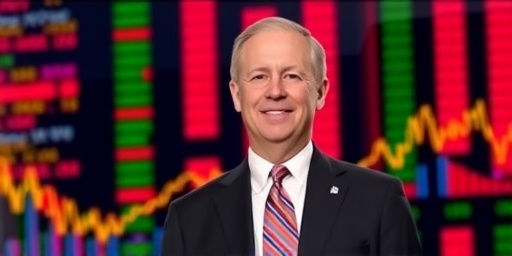In a pivotal moment for financial markets, US stock futures climbed sharply on Wednesday following Federal Reserve Chair Jerome Powell’s dovish comments hinting at a possible interest rate cut in December. Powell’s remarks, delivered during a speech at the New York Economic Club, emphasized that the Fed would consider easing monetary policy if incoming economic data continues to show cooling inflation trends. This signal triggered an immediate rally, with S&P 500 futures jumping 0.8% in after-hours trading, reflecting investor optimism about a softer landing for the US economy.
- Powell’s Dovish Pivot: Decoding the Fed Chair’s Latest Remarks
- Stock Futures Rally: S&P 500 and Beyond Feel the Fed’s Influence
- Market Experts Praise Powell’s Balancing Act on Rate Cut Expectations
- Economic Backdrop: How Cooling Inflation Fuels Fed’s Rate Cut Considerations
- Investor Strategies and Future Fed Moves: Navigating the Path Ahead
The Fed‘s potential rate cut comes at a time when inflation has moderated from its pandemic-era peaks, but persistent concerns over labor market strength and global uncertainties linger. Powell’s words provided a much-needed boost to sentiment, pushing Dow Jones Industrial Average futures up 0.6% and Nasdaq 100 futures higher by 1.1%. Traders now see a heightened probability—around 85% according to CME FedWatch Tool—of a 25-basis-point cut at the December Federal Open Market Committee (FOMC) meeting.
Powell’s Dovish Pivot: Decoding the Fed Chair’s Latest Remarks
Jerome Powell’s address was carefully worded, balancing the Fed’s dual mandate of price stability and maximum employment. Speaking to an audience of economists and business leaders, Powell noted that recent CPI data showing inflation at 2.5% year-over-year—down from over 9% in 2022—supports a case for monetary easing. ‘If the data continue to evolve as expected, we would be well-positioned to consider a rate cut in December,’ Powell stated, according to transcripts released by the Fed.
This isn’t the first time Powell has teased policy shifts, but the timing feels particularly potent amid election-year jitters and geopolitical tensions. He highlighted the resilience of the US job market, with unemployment steady at 4.1%, yet cautioned that any rate cut would be data-dependent. ‘We’re not on a preset course; our decisions will reflect the totality of the evidence,’ he added. Such language marks a subtle shift from the hawkish stance the Fed maintained through mid-2023, when aggressive hikes pushed the federal funds rate to 5.25-5.50%.
Economists point out that Powell’s comments align with the Fed’s recent dot plot, which projected two rate cuts by year-end. However, the emphasis on ‘cooling inflation signals’ underscores the central bank’s growing confidence that inflationary pressures from supply chain disruptions and energy costs are waning. For investors, this translates to lower borrowing costs ahead, potentially spurring corporate investment and consumer spending.
Stock Futures Rally: S&P 500 and Beyond Feel the Fed’s Influence
The market’s reaction was swift and decisive, with stock futures across major indices posting gains that erased earlier weekly losses. S&P 500 futures, often seen as a barometer for the broader US equity market, led the charge with a 0.8% increase, equivalent to roughly 40 points on the underlying index. This surge propelled the futures contract toward 5,800, a level not seen since July’s record highs.
Technology-heavy Nasdaq 100 futures outperformed, rising 1.1%, buoyed by expectations that lower rates would benefit growth stocks like those in AI and semiconductors. Companies such as Nvidia and Tesla, which have been sensitive to interest rate fluctuations, saw pre-market bids climb. Meanwhile, the more cyclical Dow futures advanced 0.6%, or about 250 points, driven by gains in financials and industrials that stand to gain from economic stability.
Volume in futures trading spiked by 25% compared to the previous session, per data from the Chicago Mercantile Exchange (CME), indicating heightened trader participation. Bond markets echoed the equity optimism, with 10-year Treasury yields dipping to 4.15% from 4.25%, signaling bets on easier Fed policy. Currency traders also reacted, with the US dollar index falling 0.4% against a basket of major currencies, making American exports more competitive.
Beyond the headline indices, sector-specific futures highlighted winners and laggards. Real estate investment trusts (REITs) futures soared 1.5%, as lower rates reduce financing costs for property developers. In contrast, energy futures dipped slightly, as a dovish Fed could temper oil price gains tied to economic slowdown fears.
Market Experts Praise Powell’s Balancing Act on Rate Cut Expectations
Wall Street analysts were quick to dissect Powell’s speech, viewing it as a masterclass in forward guidance. ‘This is the clearest signal yet from the Fed that December is in play,’ said Michael Feroli, chief US economist at JPMorgan Chase. ‘Powell’s hint at a rate cut if data supports it has recalibrated expectations, reducing tail risks for a recession.’
Lisa Shalett, chief investment officer at Morgan Stanley Wealth Management, echoed this sentiment in a note to clients: ‘The Fed’s pivot toward easing amid cooling inflation is a green light for risk assets. S&P 500 investors should brace for volatility, but the upside from lower rates outweighs near-term uncertainties.’ Her firm now forecasts the S&P 500 to end the year at 6,000, up from prior estimates of 5,700.
Not all views are unanimously bullish. Some experts, like Deutsche Bank’s Henry Allen, warn that over-reliance on Fed support could inflate asset bubbles. ‘While Powell’s remarks are positive, the Fed must navigate sticky services inflation and wage growth,’ Allen noted. ‘A premature rate cut risks reigniting price pressures.’ Despite such cautions, consensus among a Bloomberg survey of 50 economists pegs the odds of a December move at 82%, up from 65% pre-speech.
Institutional investors are adjusting portfolios accordingly. BlackRock, the world’s largest asset manager, increased its overweight position in US equities by 5%, citing the Fed’s supportive stance. Hedge funds, per Goldman Sachs data, have boosted leverage in stock futures by 15% this week, betting on sustained momentum.
Economic Backdrop: How Cooling Inflation Fuels Fed’s Rate Cut Considerations
The backdrop to Powell’s comments is a US economy showing signs of moderation after years of post-pandemic rebound. Inflation, as measured by the core PCE index favored by the Fed, eased to 2.7% in September, inching closer to the 2% target. This deceleration, coupled with retail sales growth slowing to 0.3% month-over-month, suggests demand is cooling without tipping into contraction.
Labor market data further supports the case for a rate cut. The September jobs report added 254,000 positions, exceeding expectations, but average hourly earnings rose just 0.2%, indicating wage pressures are abating. Powell referenced these metrics, stating, ‘The labor market remains solid, but we’re vigilant for any softening that could warrant policy adjustment.’
Global factors also play a role. The European Central Bank’s recent 25-basis-point cut and China’s stimulus measures have eased pressure on US exports. Domestically, consumer confidence indices from the Conference Board ticked up to 108.7 in October, the highest in six months, driven by hopes of cheaper mortgages and auto loans.
Yet challenges persist. Geopolitical risks, including the Middle East conflict and US election uncertainties, could disrupt supply chains and stoke inflation. The Fed’s Beige Book, released earlier this week, described economic activity as ‘modestly expanding’ across districts, with mixed reports on pricing power. These nuances explain Powell’s data-dependent approach, ensuring the rate cut path remains flexible.
Investor Strategies and Future Fed Moves: Navigating the Path Ahead
As markets digest Powell’s hints, investors are repositioning for a lower-rate environment. Strategies focusing on dividend-paying stocks in utilities and consumer staples are gaining traction, with the Vanguard Dividend Appreciation ETF seeing inflows of $500 million in the past week. Growth-oriented portfolios are tilting toward tech and healthcare, sectors poised to benefit from sustained economic expansion under easier policy.
Looking forward, key data releases will dictate the Fed’s next steps. The October nonfarm payrolls report on November 1 and the CPI figures on November 13 are pivotal. If unemployment rises above 4.2% or inflation rebounds, December’s rate cut could be deferred to 2025. Conversely, continued softening could prompt not just one, but two cuts by March, per updated projections from Wells Fargo economists.
Corporate America is also responding. Earnings calls from S&P 500 firms this quarter have increasingly cited Fed policy as a tailwind, with guidance upgrades in 60% of reports. Fed officials, including Vice Chair Philip Jefferson, are scheduled for speeches next week, potentially reinforcing Powell’s tone. For retail investors, financial advisors recommend diversifying into bonds and international equities to hedge against volatility.
In the broader landscape, a December rate cut could mark the beginning of a multi-year easing cycle, supporting stock market gains into 2025. With the S&P 500 up 22% year-to-date, the rally shows no signs of abating, but prudent risk management remains essential amid evolving economic signals.









